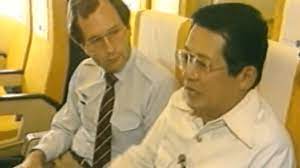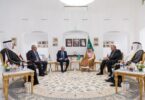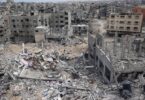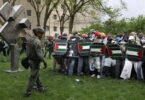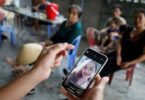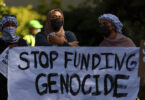Jim Laurie
It was 40 years ago. August 21, 1983. Seatbelts were fastened for landing. I had just completed my interview with Senator Benigno Aquino Jr on China Airlines Flight 811 from Taipei as it touched down at Manila International Airport. As the front door opened at Gate 8, a small group of uniformed security men boarded the plane. One of the men spotted Aquino, tapped his arm and ordered the senator to follow him off the aircraft.
Aquino’s usually smiling face turned sombre. He got up, grabbed a small shoulder bag and walked down the aisle. A crush of media tried to follow. They were blocked as Aquino was escorted down the stairs. Seconds later, a series of shots rang out. I scrambled to the nearest aircraft window. The cabin erupted in screams. All I could see was Aquino lying face down on the airport tarmac with what appeared to be a geyser of blood spewing from the back of his head. I did not see who killed him. The Philippines’s most famous and most promising opposition leader – widely known by his nickname “Ninoy” – had been shot dead upon return from exile in the United States. Among his last words to me: “If it is my fate to die by an assassin’s bullet, so be it. But I cannot be petrified by inaction or fear of assassination.”
For many Filipinos, it was the last straw. With the assassination, a People Power movement was born against longtime President Ferdinand Marcos. Staunchly backed by the Americans for 20 years, Marcos had taken the country down a dark path from democracy to martial law, human rights violations and widespread corruption. He had also left his country in economic shambles. Three years later, in February 1986, military leaders allied with Aquino’s widow, Cory, deposed Marcos. I watched as Marcos’s opponents invaded the Presidential Palace at Malacañang. They rifled through the expensive belongings bought with what many believed was the family’s vast ill-gotten wealth. The Marcos family fled to Hawaii. Spin ahead 37 years. Five men and two women have assumed the presidency since then. They include Ninoy’s widow, who provided six years of amateur leadership, focusing on poverty alleviation even as most Filipinos seemed just pleased to be rid of dictatorship. Ninoy’s son and namesake provided more competent presidential leadership from 2010 to 2016, as did the former military commander Fidel Ramos, who backed Cory’s revolution and served as president from 1992 to 1998.
There was also Joseph Estrada, an ageing actor who, along with Marcos, was later named by the Berlin-based NGO Transparency International as one of the top 10 most corrupt leaders in the world. The nation’s second woman president, Gloria Macapagal Arroyo (2001-2010), served longer than any leader since Marcos. A trained economist, she kept the nation chugging along with gross domestic product (GDP) growth rates at between 4 and 7 percent. Arroyo was plagued, however, by cheating accusations, attempted military coups and corruption charges, which were eventually dismissed. The last presidency, that of the former southern mayor, Rodrigo Duterte, who won on an anti-crime platform, ended in a cloud of accusations of extrajudicial killings and extensive human rights abuses. In many ways, the Philippines seems stuck. Now, the wheel has turned full circle and the Marcos family is back in power. Marcos’s son Ferdinand Marcos Junior, known as “Bong Bong”, has been in office a little more than a year. He won in part by waging a remarkable disinformation campaign among voters too young to remember the 1970s or ’80s. His campaign fostered nostalgia for an imagined time of prosperity and security. For most people, apart from the Marcos family, his father’s years were neither prosperous nor secure. Bong Bong seeks to rewrite or at least forget history.
Longtime investigations into the illegal acquisition of his family’s vast wealth have ended. After assuming office, his supporters in Congress moved to whitewash the historical realities of martial law. From 1972 to 1974, the first years of Marcos Senior’s military rule, Amnesty International reported more than 50,000 people arrested. They included church workers, legal aid lawyers, labour leaders and journalists.
Bong Bong’s supporters call that time a “golden era”, when the nation had to be mobilised “to fight communist and separatist rebellions”. Marcos’s supporters have also proposed removing the name of Ninoy Aquino from Manila’s International Airport and abolishing the national holiday observed on the anniversary of Ninoy’s death. To the relief of Aquino’s defenders, neither move has gained much traction.
So far, Bong Bong, who refuses to discuss the past in any depth, has pursued a cautious presidency with neither a clear blueprint nor bold actions towards domestic economic reform. In the 1980s, ’90s and 2000s, the Philippines registered the lowest economic growth in Southeast Asia. Its regional neighbours overtook it in manufacturing and economic growth. Economic growth has improved dramatically since – with GDP rates bubbling along. Yet, major issues seem intractable. A fundamental lack of industrial and agricultural development continues to this day. While the number of people living in poverty has been reduced in 40 years, at least 19 million Filipinos (or 18 percent of the population) still live on less than $5 a day. And income inequality continues to grow. The same dozen or so families who 40 years ago dominated the economy, still do. While others in the neighbourhood – China, Japan, South Korea, Vietnam, Indonesia – have built largely robust export-driven, high-tech, economic powerhouses, the Philippines’s largest export remains its people. Started as a stop-gap measure to erase unemployment and raise capital when Marcos Senior sent workers off to the Middle East in the 1970s, overseas employment has become a permanent fixture of the economy. Nearly 2 million Filipinos are overseas workers. In 2022, they sent home to their families more than $21bn in remittances. By contrast, last year, semiconductors were the leading exported electronic products with an export value of less than $3bn. Overall, government after government, president after president, catering to narrow interests, has failed to engage the true potential of the Filipino people; a people robbed of many opportunities during the Marcos Senior years.
We will never know, of course, if Benigno “Ninoy” Aquino would have provided the Philippines with the kind of leadership it needed 40 years ago. But two things are certain. Altering the truths of history is unlikely to help build a better future. And the Philippines is a nation deserving of a smarter, stronger and more effective democratic leadership than what it has had.
Aljazeera

